Author Julian Hawthorne visited the 1893 World’s Columbian Exposition in Chicago. Like so many other visitors who recorded their impressions of visiting the World’s Fair, he offered some of his highest praise for the electrical lighting of the night scene in the Dream City, a “banquet of royal beauty.”
Reprinted below is the fourth and final part of Julian Hawthorne’s “The Lady of the Lake” about his June visit to the fairgrounds and published in the August 1893 issue of Lippincott’s Magazine. The previous installment can be found in Part I, Part II, and Part III.
THE LADY OF THE LAKE
by Julian Hawthorne
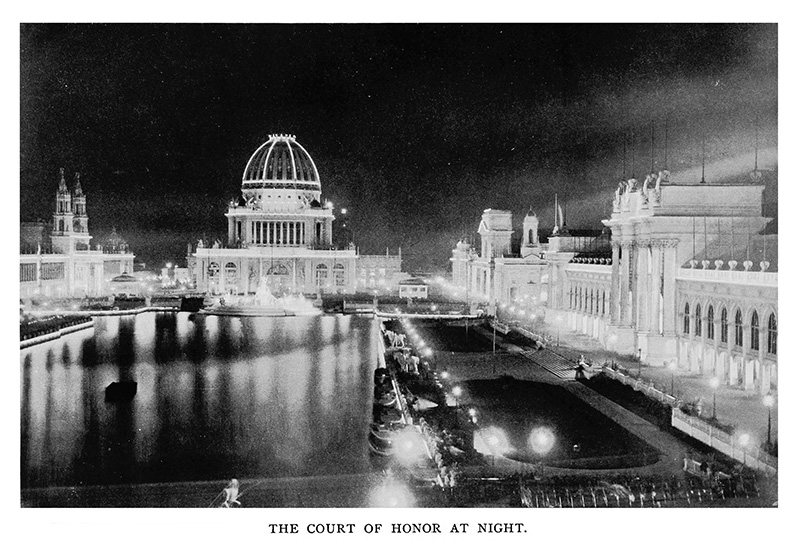
Photograph of the Court of Honor at night. [Image from Johnson, Rossiter A History of the World’s Columbian Exposition Held in Chicago in 1893. (D. Appleton and Co., 1897).]
But let us forget all our troubles, and solace ourselves with the incomparable loveliness of the illuminations.
The illumination lasts from eight o’clock till eleven, and occurs thrice a week. I went on a Saturday. It was a soft and luxurious evening, with scarce a breath of wind, and what there was from the south. The moon, nearly full, hung aloft in mid-heaven, silvery in a dark-blue velvet sky. The grounds were well filled: about one hundred thousand persons were present, according to the next morning’s papers. But most of this crowd was, of course, assembled in the great court or quadrangle containing the Lagoon, and bounded by the Manufactures and Electrical Buildings on one side, the Agricultural on the opposite side, the colonnade on the Lake end, and the Administration facing it.
The manner of the illumination was simple and almost severe, not erring on the side of profusion; and yet the effect, as enhanced by the Lagoon, was rich in the extreme. A line of incandescent electric lamps followed the long cornices of the buildings entirely round the quadrangle, rising to define the angles of the pediments and entablatures, and curving over the arched entrance of the Electrical Building. Another long line of these lamps completely encircled the margin of the Lagoon, at a height of four or five feet above the surface of the water. On the broad esplanade, between these two lines of light, stood an unbroken array of tall lamp-posts, each supporting a Brush electric lamp. These, too, formed a ring round the Lagoon.
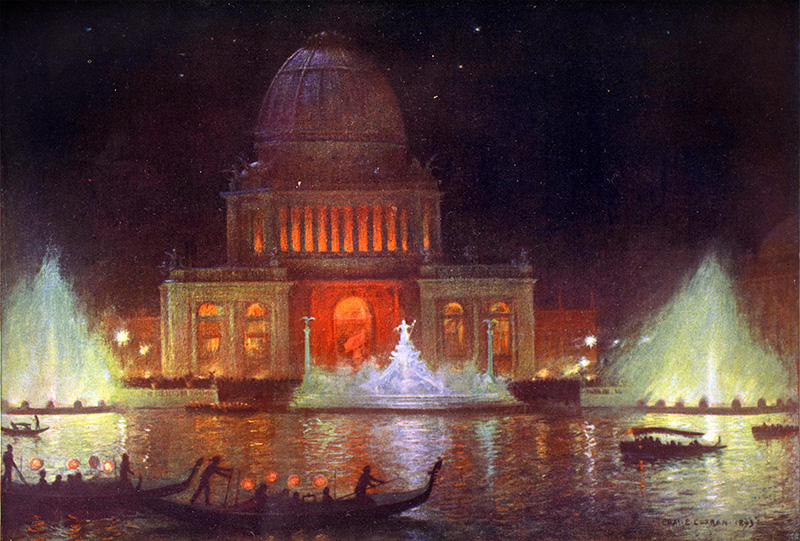
Charles Curran’s painting The Administration Building and Electric Fountains at Night. [Image from Hitchcock, Ripley The Art of the World: Illustrated in the Paintings, Statuary, and Architecture of the World’s Columbian Exposition (D. Appleton, 1894).]
The vertical ribs of the great dome of the
Administration Building were marked by incandescent lamps, and the dome was surmounted by a crown of them. On slender pillars surrounding its base were flaring torches of gas. Electric lamps likewise defined the main architectural features of the facade. Finally, beneath the arch of the colonnade on the Lake, red calcium lights were kept constantly burning, shedding over the interior of the passage a rosy glow. The interiors of all the Buildings were also faintly luminous, and a white light shone softly through the glass roof of the great Manufactures structure. The
Palace of Agriculture, which has a colonnade running all along it, was furnished with lights within the line of columns, but invisible to the spectator. The walls beyond the columns are tinted a pale salmon hue, which was illumined by these lights, and against which the white pillars defined themselves. On the dome of this building stands the golden
Diana, ravished from the tower of the New York Madison Garden: at her feet was a ring of lamps, which cast a gleam upwards over her graceful figure.
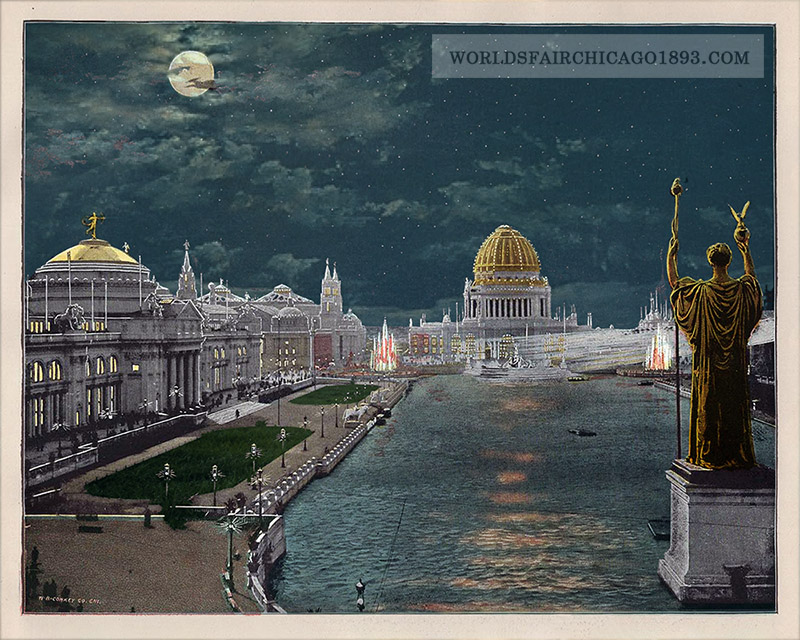
The Court of Honor by Moonlight, depicting a search light from the Manufactures and Liberal Arts Building and the statue Diana on the Agricultural Building dome. [Image from Picturesque World’s Fair (W. B. Conkey, 1894).]
Such was the arrangement, easily described; but the effect can be realized only by seeing it. The Lagoon, which cannot be less than a quarter of a mile long and about two hundred yards wide, was filled with gondolas and electric and steam launches, which circulated round and round, disturbing the otherwise placid surface of the water, and silhouetting their dark, graceful forms against the omnipresent brightness. Some of them were hung with many-colored Japanese lanterns. They were filled with people, and one carried a chorus of male voices, singing delectably. As you walked round the broad terraces surrounding the Lagoon, the ruffled water made a confused splendor of the reflected lights. The incandescent lamps, which looked like threaded beads of living gold, mingled there with the silvery reflections of the Brush lamps, so that the shining surface seemed to flash and ripple with the welded metals.
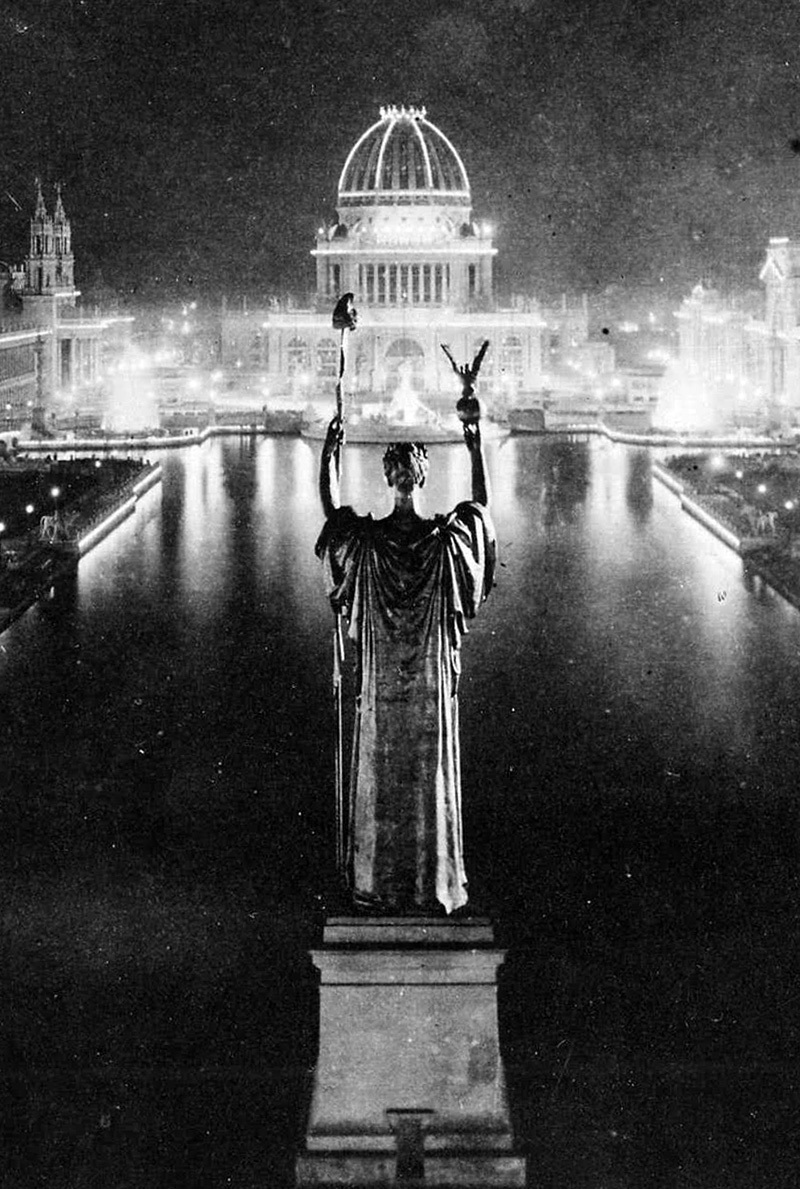
Night view of the electric lights in the Court of Honor by an unknown photographer (cropped). [Image from the Kenneth M. Swezey Papers, Archives Center, National Museum of American History, Smithsonian Institution.]
The massive golden
statue of the Republic which rises majestic at the lower end of the Lagoon caught the radiance upon its stately sides, and, as I stood gazing up at it, the moon stood just above its head, and seemed to make the figure also a denizen of the sky. From every point of view the long level lines of light charmed and enchanted the eye, and led the gaze onward to the splendid dome, whence it fell again to the fluctuating glory of the Lagoon, with its movements and its song. The harmony was on a scale so vast that the mind had to exert itself to compass it.
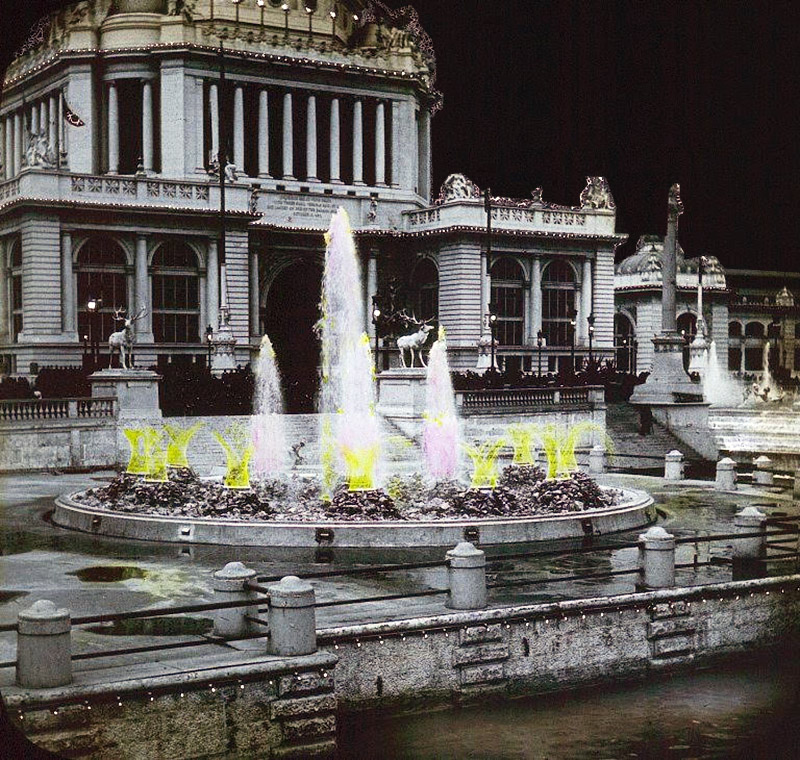
A tinted lantern slide showing the electric fountain in front of the Administration Building at night. [Image from the Brooklyn Museum, Goodyear Archival Collection.]
This, however, was not all. From the two stands on either side of the Administration Building, orchestras discoursed triumphant music in alternation, and the multitude gathered round, walking from one to the other as each took up the strain. The throbbing melody filled the mighty space, and was re-echoed from the marble cliffs, and swept in lovely pulsations over the Lagoon. And while it sounded, the architecture looked nobler and more beautiful, as if the music had given it a soul, or it were the visible embodiment of the music. And now, as if in response to a summons, the three fountains which crown the Lagoon leaped into rushing and up-reaching life; those to the right and left were illuminated from within by electric lights, which changed their hue from white to rose, and thence to azure. From various high coignes of vantage the long, keen rays of
search-lights struck across the dark, and lit upon the golden Diana on her dome, and upon the seated figure in the barge of the fountain, and upon the heights of the Administration Building, and wandered over the masses of the crowd, and over the flitting gondolas. Point after point awoke to life and distinctness as it passed.
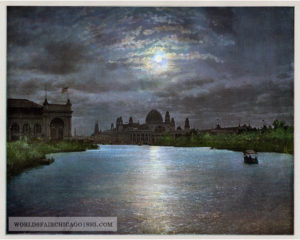
East Lagoon by Moonlight. [Based on image from Picturesque World’s Fair (W. B. Conkey, 1894).]
I got into a boat, and steamed through the rosy arch of the colonnade, and out on the broad, dark expanse of the boundless Lake. The water was smooth, and lit only by the quivering image of the moon. As we got our offing, the group of buildings on the shore assumed dim shapes of beauty; and other boats, beyond us and on either side, and lighted with many-colored lamps from stem to stern, hung like enormous jewels on the cheek of night. A search-light from the east, plunging at hazard through the transparent gloom, discovered here a ship and there a barge which the darkness had hidden. They started into sudden, intense visibility, and the next moment vanished again, like ghosts that illude the eye and then are no more.
It was a banquet of royal beauty. Returning at last to the Lagoon, I mounted flight after flight of stairs to the base of the Administration dome. Here, an undefined horizon, twinkling afar with lights, spread round on every side: below, in front, were the crowds, and the lines of lamps, the fountains and the music. I stayed and looked and listened long; for never have I beheld a fairer scene: unsentient matter seemed to dissolve and flow into poetry, and to vibrate with the spiritual beauty which we believe in, but can never grasp.
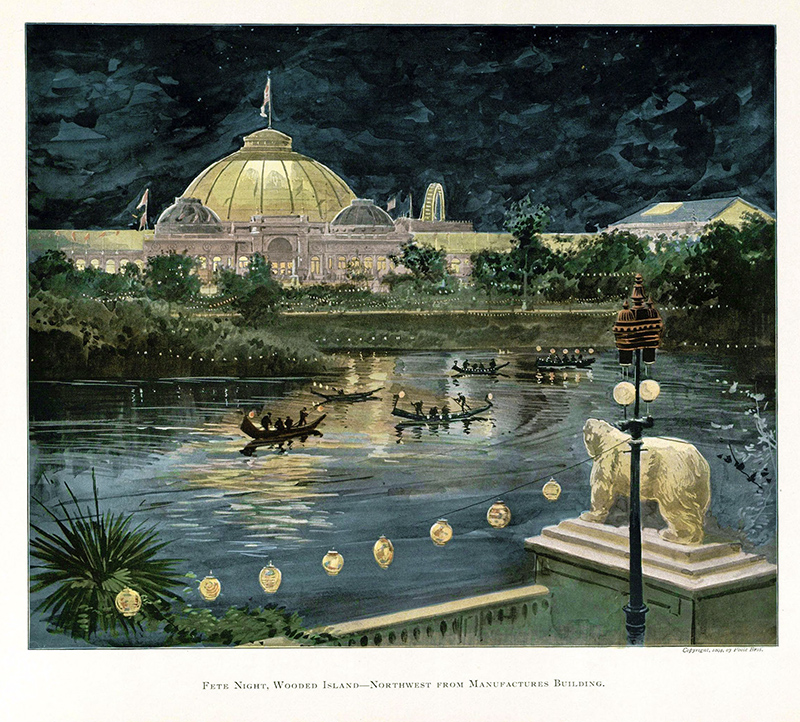
Fete Night, Wooded Island–Northwest from Manufactures Building, lithograph by the Poole Brothers. [Image from Vistas of the Fair (Poole Bros., 1894).]



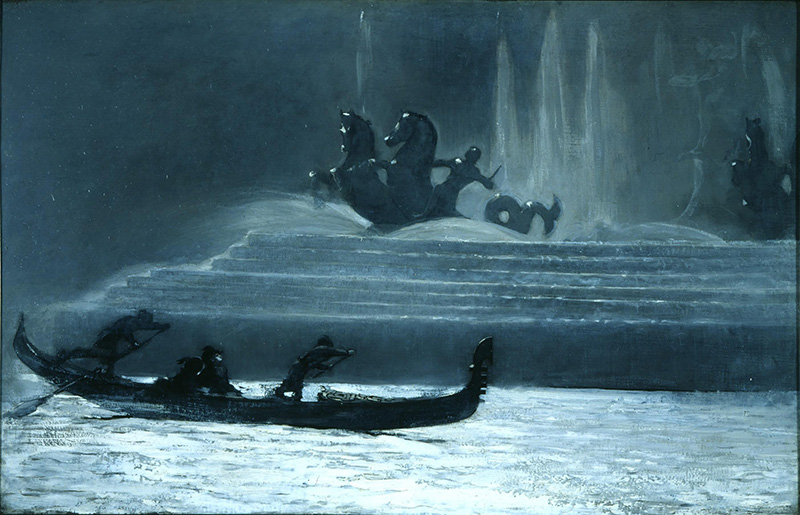





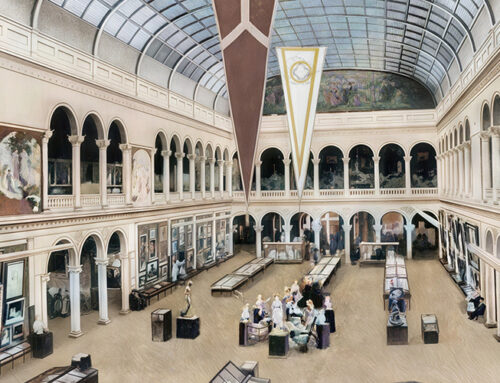
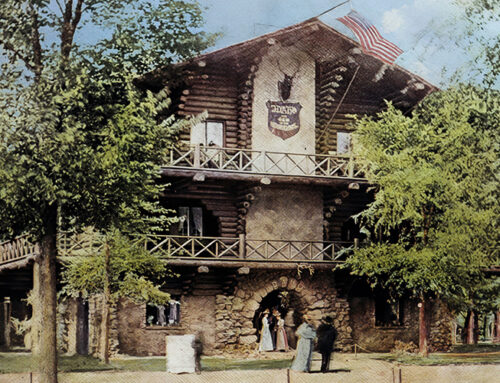
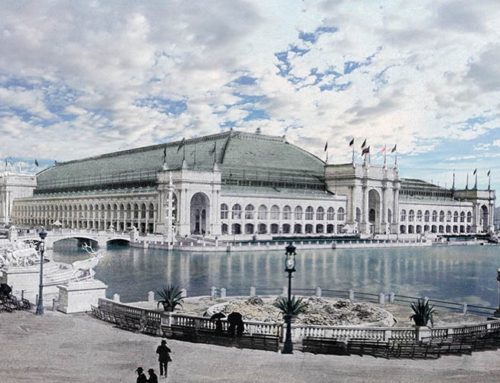
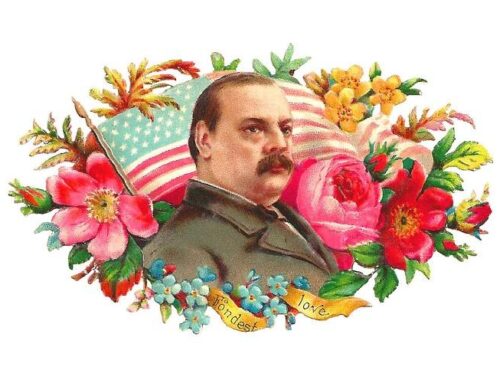

Leave A Comment